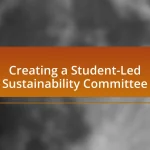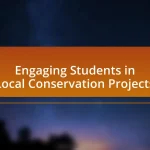Indigenous Knowledge in Environmental Education refers to the traditional ecological wisdom and practices of Indigenous peoples that inform sustainable resource management and environmental stewardship. This article explores the definition, key principles, and significance of Indigenous Knowledge, highlighting its holistic approach and differences from Western scientific knowledge. It discusses the integration of Indigenous perspectives into educational curricula, the challenges faced in this process, and the positive outcomes for student engagement and environmental attitudes. Additionally, it provides practical strategies for educators to effectively incorporate Indigenous Knowledge into environmental education, fostering respect for diverse cultural perspectives and promoting sustainability.
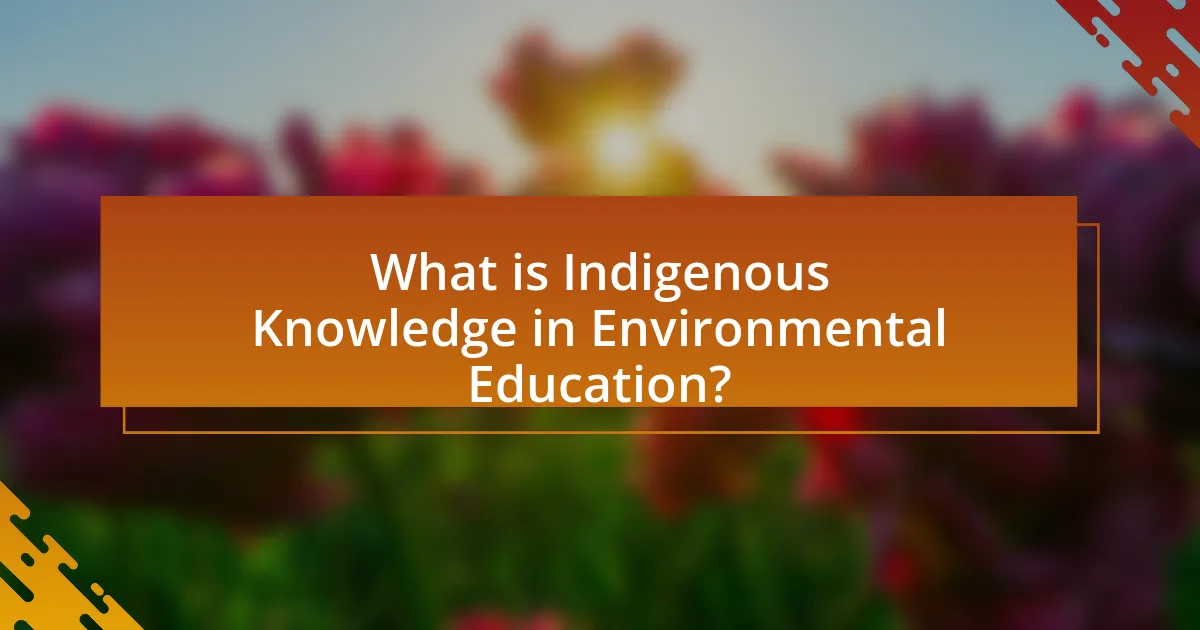
What is Indigenous Knowledge in Environmental Education?
Indigenous Knowledge in Environmental Education refers to the traditional ecological knowledge and practices of Indigenous peoples that inform their understanding of the environment and sustainable resource management. This knowledge encompasses a deep connection to the land, biodiversity, and ecosystems, often passed down through generations, and is characterized by holistic perspectives that integrate cultural, spiritual, and practical aspects of environmental stewardship. Research indicates that incorporating Indigenous Knowledge into environmental education enhances ecological literacy and promotes sustainable practices, as evidenced by studies showing improved conservation outcomes when Indigenous methods are utilized alongside scientific approaches.
How is Indigenous Knowledge defined in the context of environmental education?
Indigenous Knowledge in the context of environmental education is defined as the understanding and insights gained from the traditional practices, beliefs, and experiences of Indigenous peoples regarding their relationship with the environment. This knowledge encompasses ecological wisdom, sustainable resource management, and cultural values that have been passed down through generations. For instance, studies have shown that Indigenous land management practices, such as controlled burns, enhance biodiversity and reduce wildfire risks, demonstrating the effectiveness of this knowledge in contemporary environmental education.
What are the key principles of Indigenous Knowledge?
The key principles of Indigenous Knowledge include a deep connection to the land, holistic understanding, community-based learning, and the integration of spirituality and culture. Indigenous Knowledge emphasizes the relationship between people and their environment, recognizing that ecological systems are interconnected and that knowledge is derived from lived experiences and observations over generations. This knowledge is often shared through oral traditions and is maintained within communities, highlighting the importance of collective wisdom and cultural practices. Furthermore, Indigenous Knowledge systems are adaptive and evolve with changing environmental conditions, demonstrating resilience and sustainability in resource management.
How does Indigenous Knowledge differ from Western scientific knowledge?
Indigenous Knowledge differs from Western scientific knowledge primarily in its holistic approach and emphasis on experiential learning. Indigenous Knowledge is rooted in the cultural, spiritual, and historical contexts of specific communities, often passed down through generations, while Western scientific knowledge relies on empirical evidence, experimentation, and objective analysis. For instance, Indigenous Knowledge systems prioritize relationships with the land and ecosystems, integrating social, environmental, and spiritual dimensions, whereas Western science typically compartmentalizes these aspects for study. This distinction is evident in environmental education, where Indigenous perspectives advocate for sustainable practices based on traditional ecological knowledge, contrasting with Western methods that may focus on technological solutions.
Why is Indigenous Knowledge important for environmental education?
Indigenous Knowledge is important for environmental education because it encompasses a deep understanding of local ecosystems, sustainable practices, and biodiversity that has been developed over generations. This knowledge provides valuable insights into resource management, conservation strategies, and the interconnectedness of cultural and natural systems. For instance, Indigenous communities often utilize traditional ecological knowledge to maintain biodiversity and manage land sustainably, as evidenced by practices such as controlled burns that promote healthy ecosystems. Integrating Indigenous Knowledge into environmental education enhances the curriculum by fostering respect for diverse perspectives and promoting holistic approaches to environmental stewardship.
What role does Indigenous Knowledge play in sustainability practices?
Indigenous Knowledge plays a crucial role in sustainability practices by providing time-tested ecological insights and management strategies that promote environmental stewardship. This knowledge, rooted in the cultural and spiritual connections of Indigenous peoples to their land, emphasizes the importance of biodiversity, ecosystem health, and sustainable resource use. For example, Indigenous agricultural practices, such as polyculture and crop rotation, have been shown to enhance soil fertility and resilience against climate change, as documented in studies like “Indigenous Knowledge and Sustainable Development” by Berkes et al. (2000). These practices not only contribute to food security but also foster a holistic understanding of the interconnectedness of all living systems, which is essential for effective sustainability efforts.
How can Indigenous Knowledge enhance ecological understanding?
Indigenous Knowledge enhances ecological understanding by providing insights into sustainable practices and biodiversity management developed over generations. This knowledge encompasses traditional ecological practices, such as controlled burning and seasonal harvesting, which have been shown to maintain ecosystem health. For example, research indicates that Indigenous land management techniques in Australia, such as fire-stick farming, have led to increased biodiversity and reduced wildfire risks, demonstrating the effectiveness of these practices in ecological stewardship. By integrating Indigenous Knowledge with scientific approaches, a more holistic understanding of ecosystems can be achieved, benefiting conservation efforts and environmental education.
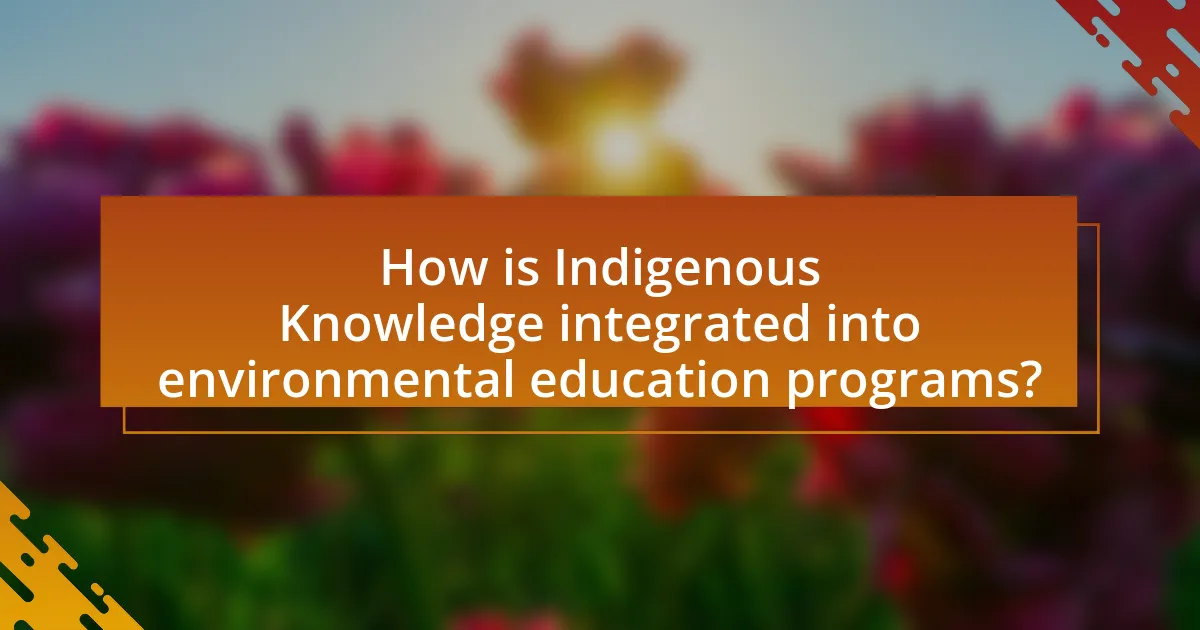
How is Indigenous Knowledge integrated into environmental education programs?
Indigenous Knowledge is integrated into environmental education programs through collaborative curricula that incorporate traditional ecological knowledge, cultural practices, and local environmental stewardship. This integration often involves partnerships between Indigenous communities and educational institutions, ensuring that Indigenous perspectives are respected and accurately represented. For example, programs may include place-based learning that emphasizes the significance of local ecosystems as understood by Indigenous peoples, thereby fostering a deeper connection to the land. Research indicates that such integration enhances students’ understanding of biodiversity and sustainability, as evidenced by studies showing improved environmental attitudes among participants in programs that include Indigenous perspectives.
What are the methods for incorporating Indigenous Knowledge into curricula?
Incorporating Indigenous Knowledge into curricula can be achieved through methods such as collaborative partnerships with Indigenous communities, integration of traditional ecological knowledge, and the inclusion of Indigenous perspectives in lesson plans. Collaborative partnerships allow educators to work directly with Indigenous elders and knowledge holders, ensuring that the content is authentic and culturally relevant. Integrating traditional ecological knowledge involves teaching students about Indigenous practices related to land management, biodiversity, and sustainability, which can enhance environmental education. Additionally, including Indigenous perspectives in lesson plans fosters a more holistic understanding of environmental issues, as it encourages students to appreciate diverse worldviews and approaches to nature. These methods are supported by educational frameworks that emphasize respect for Indigenous cultures and the importance of experiential learning.
How can educators collaborate with Indigenous communities?
Educators can collaborate with Indigenous communities by engaging in respectful partnerships that prioritize Indigenous knowledge and perspectives in environmental education. This collaboration can involve co-developing curricula that integrate traditional ecological knowledge, which has been shown to enhance environmental stewardship and cultural understanding. For instance, studies indicate that incorporating Indigenous practices in environmental education leads to improved student engagement and a deeper appreciation for biodiversity. Additionally, educators can facilitate community-led workshops and field trips that allow students to learn directly from Indigenous elders and knowledge keepers, fostering mutual respect and understanding.
What resources are available for teaching Indigenous perspectives?
Resources available for teaching Indigenous perspectives include educational frameworks, literature, multimedia materials, and community engagement opportunities. For instance, the “First Nations Principles of Learning” framework provides guidelines for integrating Indigenous knowledge into curricula. Additionally, books such as “Braiding Sweetgrass” by Robin Wall Kimmerer and “The Marrow Thieves” by Cherie Dimaline offer narratives that reflect Indigenous worldviews. Multimedia resources like the “Indigenous Education: A Guide for Teachers” video series and online platforms such as the National Museum of the American Indian’s educational resources also support educators. Engaging with local Indigenous communities through workshops and cultural events further enriches the learning experience by providing firsthand insights into Indigenous perspectives.
What challenges exist in integrating Indigenous Knowledge into environmental education?
Integrating Indigenous Knowledge into environmental education faces several challenges, primarily stemming from differing worldviews and epistemologies. Indigenous Knowledge often emphasizes holistic, relational understandings of the environment, which can conflict with Western scientific approaches that prioritize empirical data and individualism. This epistemological clash can lead to misunderstandings and misinterpretations of Indigenous perspectives.
Additionally, there is often a lack of representation and inclusion of Indigenous voices in educational curricula, which can perpetuate stereotypes and marginalize Indigenous contributions to environmental stewardship. For instance, a study by the National Congress of American Indians highlights that educational systems frequently overlook Indigenous methodologies, resulting in a gap in authentic representation.
Furthermore, institutional barriers, such as rigid educational frameworks and standardized testing, can hinder the incorporation of Indigenous Knowledge. These frameworks may not allow for the flexibility needed to integrate culturally relevant content effectively. Overall, these challenges necessitate a concerted effort to bridge the gap between Indigenous Knowledge and formal environmental education systems.
How can misconceptions about Indigenous Knowledge be addressed?
Misconceptions about Indigenous Knowledge can be addressed through education and inclusive dialogue. Educational programs that incorporate Indigenous perspectives and practices can help dispel myths and promote understanding. For instance, integrating Indigenous ecological knowledge into environmental education curricula has been shown to enhance students’ appreciation of diverse knowledge systems, as evidenced by studies highlighting improved environmental stewardship among participants. Additionally, fostering partnerships between Indigenous communities and educational institutions can facilitate the sharing of authentic knowledge, further correcting misconceptions and promoting respect for Indigenous ways of knowing.
What barriers do educators face when implementing Indigenous perspectives?
Educators face several barriers when implementing Indigenous perspectives, including a lack of resources, insufficient training, and systemic biases within educational frameworks. The absence of culturally relevant materials limits educators’ ability to effectively teach Indigenous knowledge. Additionally, many educators report feeling unprepared to integrate Indigenous perspectives due to inadequate professional development opportunities that focus on these topics. Systemic biases in curricula often prioritize Western viewpoints, which can marginalize Indigenous voices and knowledge systems. These barriers hinder the meaningful inclusion of Indigenous perspectives in environmental education, ultimately affecting students’ understanding and appreciation of diverse worldviews.
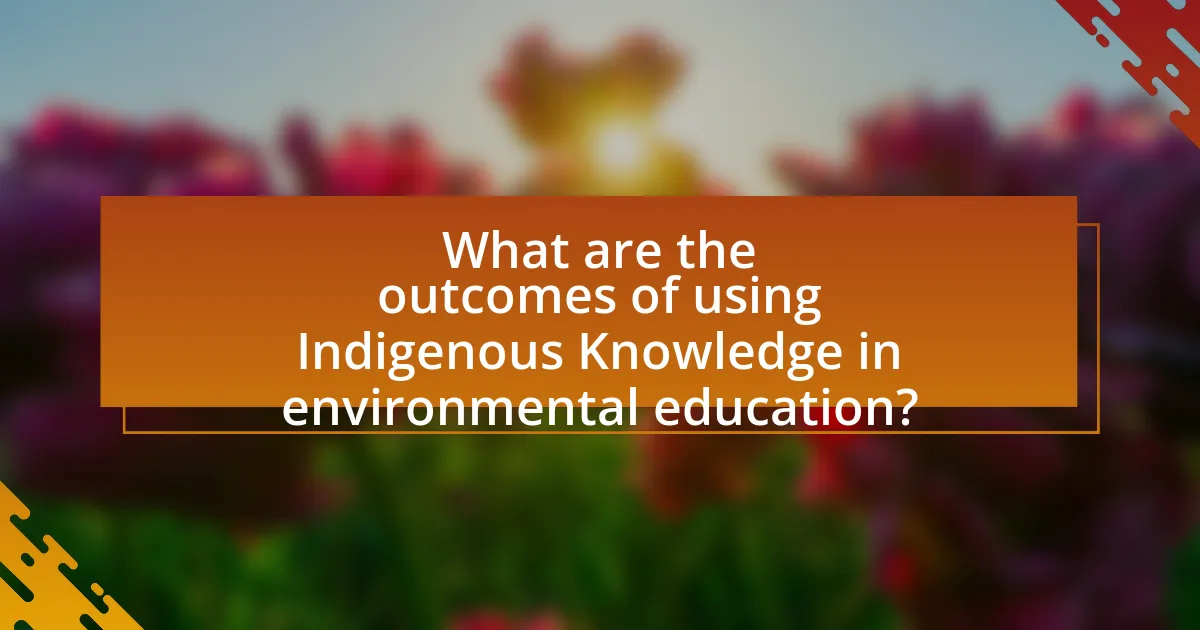
What are the outcomes of using Indigenous Knowledge in environmental education?
The outcomes of using Indigenous Knowledge in environmental education include enhanced ecological understanding, improved community engagement, and the promotion of sustainable practices. Indigenous Knowledge systems provide insights into local ecosystems, biodiversity, and resource management that are often overlooked in conventional education. For instance, studies have shown that integrating Indigenous perspectives can lead to better conservation outcomes, as Indigenous communities have historically managed their environments sustainably for generations. Additionally, incorporating these knowledge systems fosters respect for cultural diversity and encourages collaborative learning, which can strengthen community ties and promote environmental stewardship.
How does Indigenous Knowledge impact student engagement and learning?
Indigenous Knowledge significantly enhances student engagement and learning by integrating culturally relevant perspectives into educational frameworks. This approach fosters a sense of belonging and relevance among students, particularly those from Indigenous backgrounds, as it validates their cultural identity and experiences. Research indicates that when Indigenous Knowledge is incorporated into curricula, students demonstrate increased motivation, participation, and academic performance. For instance, a study by the University of Alberta found that students exposed to Indigenous perspectives in environmental education showed improved critical thinking skills and a deeper understanding of ecological concepts. This evidence underscores the positive impact of Indigenous Knowledge on both engagement and learning outcomes in educational settings.
What evidence supports the effectiveness of Indigenous Knowledge in education?
Indigenous Knowledge has been shown to enhance educational outcomes through culturally relevant pedagogy and improved student engagement. Research indicates that integrating Indigenous Knowledge into curricula leads to higher academic achievement and increased cultural identity among Indigenous students. For instance, a study by the University of Alberta found that students who participated in programs incorporating Indigenous perspectives demonstrated improved critical thinking skills and a deeper understanding of environmental issues. Additionally, the “Indigenous Knowledge and Education” report by the National Indian Education Association highlights that such integration fosters respect for diverse worldviews and promotes environmental stewardship, thereby validating the effectiveness of Indigenous Knowledge in educational settings.
How does Indigenous Knowledge influence students’ attitudes towards the environment?
Indigenous Knowledge significantly influences students’ attitudes towards the environment by fostering a deep respect for nature and promoting sustainable practices. This knowledge system emphasizes interconnectedness between humans and the environment, encouraging students to view ecological systems holistically. Research indicates that when students engage with Indigenous perspectives, such as traditional ecological knowledge, they develop a greater sense of responsibility and stewardship towards natural resources. For instance, a study by the University of Alberta found that incorporating Indigenous teachings in environmental curricula led to increased environmental awareness and pro-environmental behaviors among students. This demonstrates that Indigenous Knowledge not only enriches educational content but also shapes positive environmental attitudes in learners.
What best practices can educators adopt when using Indigenous Knowledge?
Educators can adopt several best practices when using Indigenous Knowledge, including collaboration with Indigenous communities, integrating local cultural perspectives into the curriculum, and promoting experiential learning. Collaborating with Indigenous communities ensures that the knowledge shared is authentic and respects the cultural context, as seen in programs like the “Elders in Schools” initiative, which connects students with Indigenous elders for firsthand learning experiences. Integrating local cultural perspectives into the curriculum allows students to understand the relevance of Indigenous Knowledge in contemporary environmental issues, fostering a sense of respect and appreciation for diverse worldviews. Promoting experiential learning through activities such as land-based education helps students engage directly with the environment, reinforcing the practical applications of Indigenous Knowledge in sustainability and conservation practices.
How can educators ensure respectful representation of Indigenous cultures?
Educators can ensure respectful representation of Indigenous cultures by actively involving Indigenous communities in the curriculum development process. This approach fosters authenticity and accuracy in the portrayal of Indigenous knowledge and practices. For instance, the inclusion of Indigenous voices and perspectives in educational materials can enhance understanding and respect for their cultural heritage. Research indicates that when Indigenous peoples participate in educational initiatives, it leads to more meaningful and respectful representations (Smith, 2012, “Decolonizing Methodologies: Research and Indigenous Peoples”). By prioritizing collaboration with Indigenous leaders and educators, institutions can create a learning environment that honors and respects Indigenous cultures.
What strategies can be employed to create inclusive learning environments?
To create inclusive learning environments, educators can implement culturally responsive teaching strategies that recognize and value diverse cultural backgrounds. This approach involves integrating Indigenous knowledge and perspectives into the curriculum, which fosters a sense of belonging among all students. Research indicates that when students see their cultures reflected in the learning material, their engagement and academic performance improve (Ladson-Billings, 1994). Additionally, employing collaborative learning techniques encourages peer interaction and respect for different viewpoints, further enhancing inclusivity. By actively involving families and communities in the educational process, schools can create a supportive network that reinforces the importance of diverse perspectives in learning.
What are practical tips for implementing Indigenous Knowledge in environmental education?
Practical tips for implementing Indigenous Knowledge in environmental education include collaborating with Indigenous communities to integrate their perspectives and practices into curricula. Engaging local Indigenous elders and knowledge holders can provide authentic insights into sustainable practices and ecological stewardship. Additionally, incorporating place-based learning that emphasizes local ecosystems and Indigenous histories fosters a deeper understanding of environmental issues. Research shows that such integration enhances students’ cultural awareness and respect for biodiversity, as evidenced by studies highlighting improved environmental attitudes among students exposed to Indigenous perspectives.

